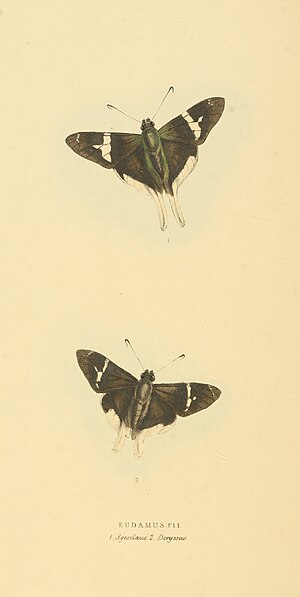Zoological Illustrations Series II/Plate 48
EUDAMUS Pl.1.
1. Agesilaus. 2. Doryssus.
EUDAMUS Agesilaus.
Family Hesperidæ.—Nob. (Anopluriform Stirps. Horsf.)
Generic Character.
Antennæ with the club unequally fusiform, the outer half abruptly bent, forming a lengthened, attenuated hook, alike in both sexes; anterior wings papilioniform: posterior wings with the caudal appendages very long and obtuse.
Type.—Hesperia Proteus. Fab.
Specific Character.
Posterior wings dark brown, with a broad, entire, cream coloured margin; beneath marked with two darker bands, and a basal dot: appendages very long, whiteish.
The insects composing this group, have only been discovered in the hot latitudes of America. In the Systema Naturæ one species alone is recorded; Fabricius was acquainted with three; our own cabinet possesses eighteen, all collected in a comparatively insignificant portion of Brazil. Others have been figured by Drury and Cramer, so that the number of species already known, may probably amount to near thirty.
The flight of these Swallow-tailed Hesperidæ, is usually performed in the morning and evening, and is so rapid, as frequently to elude the eye of the observer. They rest with all the four wings perpendicular, similar to the Swallow-tailed Butterflies, (P. Machaon, &c.) The present is a very rare species; we captured only two specimens near Bahia.
EUDAMUS Doryssus.
Posterior wings, with short snowy tails, and a half border of white on both sides; beneath brown, with a few paler dots near the base.
The sexes of this species materially differ. Our figure represents the female: in the male, the wings are browner, and highly glossed at their base with green; the snowy border on the posterior wings is very narrow above, but much broader beneath. It appears very locally distributed; we found it common in the vicinity of Bahia.

